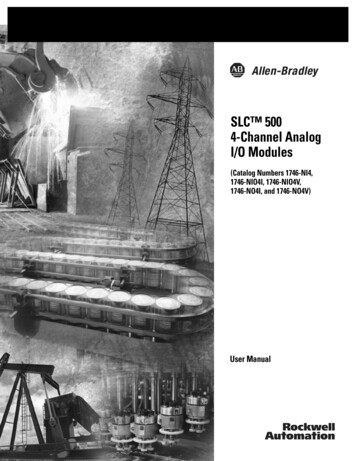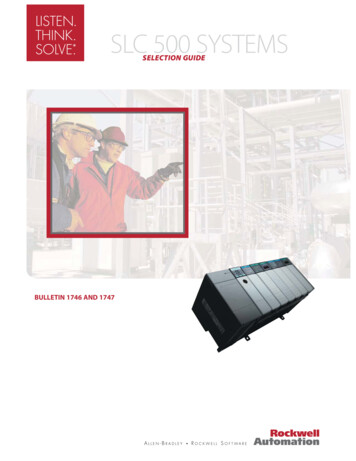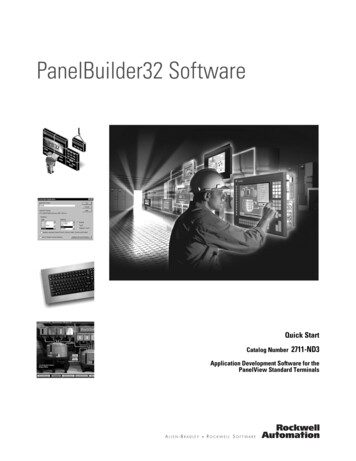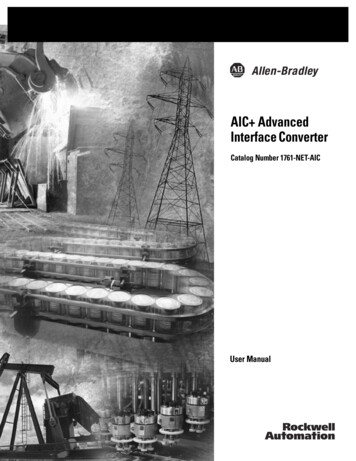
Transcription
SLC 5004-Channel AnalogI/O Modules(Catalog Numbers 1746-NI4,1746-NIO4I, 1746-NIO4V,1746-NO4I, and 1746-NO4V)User Manual
Important User InformationSolid state equipment has operational characteristics differing from those ofelectromechanical equipment. Safety Guidelines for the Application,Installation and Maintenance of Solid State Controls (Publication SGI-1.1available from your local Rockwell Automation sales office or online athttp://www.ab.com/manuals/gi) describes some important differencesbetween solid state equipment and hard-wired electromechanical devices.Because of this difference, and also because of the wide variety of uses forsolid state equipment, all persons responsible for applying this equipmentmust satisfy themselves that each intended application of this equipment isacceptable.In no event will Rockwell Automation, Inc. be responsible or liable forindirect or consequential damages resulting from the use or application ofthis equipment.The examples and diagrams in this manual are included solely for illustrativepurposes. Because of the many variables and requirements associated withany particular installation, Rockwell Automation, Inc. cannot assumeresponsibility or liability for actual use based on the examples and diagrams.No patent liability is assumed by Rockwell Automation, Inc. with respect touse of information, circuits, equipment, or software described in this manual.Reproduction of the contents of this manual, in whole or in part, withoutwritten permission of Rockwell Automation, Inc. is prohibited.Throughout this manual we use notes to make you aware of tifies information about practices or circumstancesthat can cause an explosion in a hazardous environment,which may lead to personal injury or death, propertydamage, or economic loss.Identifies information that is critical for successfulapplication and understanding of the product.Identifies information about practices or circumstancesthat can lead to personal injury or death, propertydamage, or economic loss. Attentions help you: identify a hazard avoid a hazard recognize the consequenceSHOCK HAZARDLabels may be located on or inside the drive to alertpeople that dangerous voltage may be present.BURN HAZARDLabels may be located on or inside the drive to alertpeople that surfaces may be dangerous temperatures.
Summary of ChangesThe information below summarizes the changes to this manual sincethe last printing.To help you find new and updated information in this release of themanual, we have included change bars as shown to the right of thisparagraph.For information on:See:SCP (scale with parameters) instruction available with SLC 6-3, 6-9, 6-15, 6-215/05Change in Impedance to ANL Com specification for NI4Series B moduleA-1Change in Impedance Channel to Channel specification forNI4 Series B moduleA-1Change in Input Impedance specification for NI4 Series BmoduleA-4Change in resistance value for NI4 Series B moduleAppendix DPublication 1746-UM005B-EN-P - June 2004
2Summary of ChangesPublication 1746-UM005B-EN-P - June 2004
Table of ContentsPrefaceWho Should Use this Manual. . . . . . . . . . . . . . . .Purpose of this Manual . . . . . . . . . . . . . . . . . . . .Related Documentation . . . . . . . . . . . . . . . . .Common Techniques Used in this Manual . . . . . .Your Questions or Comments on this Manual .P-1P-1P-2P-3P-3How to Use Analog. . . . . . . . . . . . . . . . . . . . . . . . . . . . .Types of Analog Modules . . . . . . . . . . . . . . . . . . . . . . . .1746-NI4 Analog Input Module. . . . . . . . . . . . . . . . . .1746-NIO4I and NIO4V Analog Combination Modules.1746-NO4I and NO4V Analog Output Modules . . . . . .1-11-11-21-21-2Chapter 1OverviewChapter 2Quick Start for Experienced Users Required Tools and Equipment . . . . . . . . . . . . . . . . . . . . . 2-1Procedures . . . . . . . . . . . . . . . . . . . . . . . . . . . . . . . . . . . . 2-2Chapter 3Installing and Wiring Your Analog European Union Directive Compliance . . . . . . . . . . . . . . . 3-1EMC Directives . . . . . . . . . . . . . . . . . . . . . . . . . . . . . . 3-1ModuleDetermining Your Power Requirements for a ModularController . . . . . . . . . . . . . . . . . . . . . . . . . . . . . . . . . . . .Determining Your Power Requirements for a FixedController . . . . . . . . . . . . . . . . . . . . . . . . . . . . . . . . . . . .Configuring Your Module . . . . . . . . . . . . . . . . . . . . . . . .Switch Settings for the 1746–NI4. . . . . . . . . . . . . . . . .Switch Settings for the 1746-NIO4I and -NIO4V. . . . . .External Power Switch for the 1746-NO4I and -NO4V .Choosing a Slot in the Chassis . . . . . . . . . . . . . . . . . . . . .Installing Your Module . . . . . . . . . . . . . . . . . . . . . . . . . .Removing the Analog Module Terminal Block. . . . . . .Wiring Considerations . . . . . . . . . . . . . . . . . . . . . . . . . . .System Wiring Guidelines. . . . . . . . . . . . . . . . . . . . . .Grounding Your Cable. . . . . . . . . . . . . . . . . . . . . . . .Determining the Cable Length . . . . . . . . . . . . . . . . . .Wiring the Analog Module. . . . . . . . . . . . . . . . . . . . . . . .Labeling and Installing the Terminal Block. . . . . . . . . . . .Grounding the Foil Shields and Drain Wires. . . . . . . . . . .Wiring Schematics for 2, 3, and 4-Wire Analog InputDevices . . . . . . . . . . . . . . . . . . . . . . . . . . . . . . . . . . .Wiring Schematic for Single-ended Analog InputConnections . . . . . . . . . . . . . . . . . . . . . . . . . . . . . . .Minimizing Electrical Noise on Analog Modules . . . . . . . .i. -12. 3-14. 3-15. 3-15Publication 1746-UM005B-EN-P - June 2004
Table of ContentsiiChapter 4Module Operation and SystemConsiderationsInterface between the Module and the ProcessorEntering Module ID Codes . . . . . . . . . . . . . .Addressing Analog Modules . . . . . . . . . . . . .Bit Level Addressing . . . . . . . . . . . . . . . . . .Processor Update of Analog Data . . . . . . . . .Monitoring the Input and Output Data . . . . .Converting Analog Input Data . . . . . . . . . . .Converting Analog Output Data . . . . . . . . . .System Considerations. . . . . . . . . . . . . . . . . . . .Safe State for Outputs . . . . . . . . . . . . . . . . .Retentive Programming Option. . . . . . . . . . .Retentive Analog Output Example . . . . . . . .Non-Retentive Analog Output Example. . . . .During a Mode Change or Power Cycle . . . .Input Out-of-Range Detection. . . . . . . . . . . .Response to Slot Disable . . . . . . . . . . . . . . .Input Response to Slot Disable . . . . . . . . . . .Output Response to Slot Disable . . . . . . . . .Input Channel Filtering . . . . . . . . . . . . . . . 4-134-134-134-14.5-15-15-25-25-35-45-6Chapter 5Testing Your ModuleTesting the SLC 500 System . . . . . . . . . . . . . . .Start-up Procedures . . . . . . . . . . . . . . . . . .Inspect the Analog Module. . . . . . . . . . . . .Disconnect Prime Movers (Motion Devices)Power Up the SLC 500 System . . . . . . . . . .Testing Analog Inputs . . . . . . . . . . . . . . . .Testing Analog Outputs . . . . . . . . . . . . . . .Chapter 6Programming ExamplesPublication 1746-UM005B-EN-P - June 2004Addressing, Out-of-Range Detection, and Scaling of AnalogInputs. . . . . . . . . . . . . . . . . . . . . . . . . . . . . . . . . . . . . . . .Calculating the Linear Relationship . . . . . . . . . . . . . . . .Calculating the Out-of-Range Flag Using the ScaleInstruction . . . . . . . . . . . . . . . . . . . . . . . . . . . . . . . . . .Using Standard Math . . . . . . . . . . . . . . . . . . . . . . . . . .Using the Scale (SCL) Instruction . . . . . . . . . . . . . . . . .Using Scale with Parameters (SCP) Instruction. . . . . . . .Addressing and Scaling Outputs. . . . . . . . . . . . . . . . . . . . .Calculating the Linear Relationship . . . . . . . . . . . . . . . .Using Standard Math . . . . . . . . . . . . . . . . . . . . . . . . . .Using the Scale with Parameters (SCP) Instruction . . . . .Scaling Offset when 32,767 or -32,768 . . . . . . . . . . . . .Calculating the Linear Relationship . . . . . . . . . . . . . . . .6-16-26-36-46-66-76-86-86-106-126-146-14
Table of ContentsCalculating the Shifted Linear Relationship . . . . . .Using Standard Math . . . . . . . . . . . . . . . . . . . . . .Using the Scale with Parameters (SCP) Instruction .Scaling and Range Checking and Analog Inputs andOutputs . . . . . . . . . . . . . . . . . . . . . . . . . . . . . . . . . .Calculating the Linear Relationship . . . . . . . . . . . .Using Standard Math Instructions . . . . . . . . . . . . .Scaling and Range Checking of Analog Inputs andOutputs . . . . . . . . . . . . . . . . . . . . . . . . . . . . . . . . . .Using SCL Instruction . . . . . . . . . . . . . . . . . . . . . .Using the Scale with Parameters (SCP) Instruction .iii. . . . 6-15. . . . 6-16. . . . 6-18. . . . 6-20. . . . 6-21. . . . 6-22. . . . 6-24. . . . 6-25. . . . 6-26Chapter 7Maintenance and SafetyPreventative Maintenance . . . . . . . . . . . . . . . . . . . . . . . . . 7-1Safety Considerations When Troubleshooting . . . . . . . . . . . 7-2Appendix ASpecificationsAnalog Modules Specification . . . . . . . . . . . . . . . . . . . . .General Specifications for NI4, NIO4I, NIO4V, NO4I, andNO4V . . . . . . . . . . . . . . . . . . . . . . . . . . . . . . . . . . . . . . .General Analog Input Specifications for NI4, NIO4I, andNIO4V . . . . . . . . . . . . . . . . . . . . . . . . . . . . . . . . . . . . . .Current-Loop Input Specifications for NI4, NIO4I, andNIO4V . . . . . . . . . . . . . . . . . . . . . . . . . . . . . . . . . . . . . .Voltage Input Specifications for NI4, NIO4I, and NIO4V . .Current Output Specifications for NIO4I and NO4I . . . . . .Voltage Output Specifications for NIO4V and NO4V. . . . . A-1. A-1. A-2.A-3A-4A-5A-6Appendix BTwo’s Complement BinaryNumbersPositive Decimal Values . . . . . . . . . . . . . . . . . . . . . . . . A-1Negative Decimal Values . . . . . . . . . . . . . . . . . . . . . . . A-2Appendix COptional Analog Input SoftwareCalibrationCalibrating an Analog Input Channel . . . . . . . . . . . . . . . . . A-1Calculating the Software Calibration . . . . . . . . . . . . . . . A-2Appendix DModule Input and Output CircuitsIndexPublication 1746-UM005B-EN-P - June 2004
Table of ContentsivPublication 1746-UM005B-EN-P - June 2004
PrefaceRead this preface to familiarize yourself with the rest of the manual. Itprovides information concerning: Who Should Use thisManualwho should use this manualthe purpose of this manualrelated documentationconventions used in this manualRockwell Automation supportUse this manual if you are responsible for designing, installing,programming, or troubleshooting control systems that use SLC 5004-Channel Analog I/O Modules.You should have a basic understanding of electrical circuitry andfamiliarity with relay logic. If you do not, obtain the proper trainingbefore using this product.Purpose of this ManualThis manual describes the procedures you use to install, wire, andtroubleshoot your 4-channel analog I/O module. This manual: explains how to install and wire your module gives you an overview of the SLC 500 programmable controllersystemRefer to your programming software user documentation for moreinformation on programming your SLC 500 programmable controller.1Publication 1746-UM005B-EN-P - June 2004
2PrefaceRelated DocumentationThe following documents contain additional information concerningRockwell Automation products. To obtain a copy, contact your localRockwell Automation office or distributor.ForRead this DocumentDocument NumberIn-depth information on the SLC Instruction Set.SLC 500 Instruction Set Reference Manual1747-RM001A description on how to install and use your Modular SLC 500programmable controller.SLC 500 Modular Hardware Style UserManual1747-UM011A description on how to install and use your Fixed SLC 500programmable controller.SLC 500 Fixed Hardware Style Installation & 1747-6.21Operation ManualA description on how to install 4-channel analog I/O modulesSLC 500 4-Channel Analog I/O ModulesInstallation Instructions1746-IN008Information on reducing electrical noise.System Design for Control of ElectricalNoiseGMC-RM001In-depth information on grounding and wiring Allen-Bradley programmable controllers.Allen-Bradley Programmable ControllerGrounding and Wiring Guidelines1770-4.1A description of important differences between solid-stateApplication Considerations for Solid-Stateprogrammable controller products and hard-wired electromechanical Controlsdevices.SGI-1.1An article on wire sizes and types for grounding electricalequipment.National Electrical Code - Published by the National Fire ProtectionAssociation of Boston, MA.A glossary of industrial automation terms and abbreviations.Allen-Bradley Industrial AutomationGlossaryPublication 1746-UM005B-EN-P - June 2004AG-7.1
Preface3If you would like a manual, you can: download an electronic version from the internet at:– www.theautomationbookstore.com– http://ab.com/manuals order a printed manual by:– contacting your local distributor or Rockwell Automationrepresentative– visiting www.theautomationbookstore.com– calling 1.800.963.9548 (USA/Canada) or 001.330.725.1574(Outside USA/Canada)Common Techniques Usedin this ManualThe following conventions are used throughout this manual: Bulleted lists such as this one provide information, notprocedural steps. Numbered lists provide sequential steps or hierarchicalinformation. Italic type is used for emphasis.Your Questions or Comments on this ManualIf you find a problem with this manual, or you have any suggestionsfor how this manual could be made more useful to you, pleasecontact us at the address below:Rockwell AutomationAutomation Control and Information GroupTechnical Communication, Dept. A602VP.O. Box 2086Milwaukee, WI 53201-2086Publication 1746-UM005B-EN-P - June 2004
4PrefacePublication 1746-UM005B-EN-P - June 2004
Chapter1OverviewThis chapter describes how analog is used and provides twoapplication examples of analog. The types of available analogmodules and their related specifications are also described.How to Use AnalogAnalog refers to the representation of numerical quantities by themeasurement of continuous physical variables. Analog applicationsare present in many forms. The following application shows a typicaluse of analog.In this application the processor controls the amount of fluid placed ina holding tank by adjusting the percentage of the valve opening. Thevalve is initially open 100%. As the fluid level in the tank approachesthe preset point, the processor modifies the output to degrade closingthe valve 90%, 80%, adjusting the valve to maintain a set point.Analog OutputValveCPULevel SensorAnalog I/OModuleAnalog InputTypes of Analog Modules1The following sections provide an overview of the various analogmodules.Publication 1746-UM005B-EN-P - June 2004
1-2Overview1746-NI4 Analog Input ModuleThe 1746-NI4 Analog Input module contains 4 analog input channelsthat are user selectable per channel for voltage or current to support avariety of monitoring and controlling applications1746-NIO4I and NIO4V Analog Combination ModulesThe NIO4I and NIO4V Analog Combination I/O modules provide twoinput and two output channels in a single slot module. The1746-NIO4I module contains two current or voltage inputs (userselectable per channel), and two current outputs. The 176-NIO4Vmodule contains two current or voltage inputs (user selectable perchannel) and two voltage outputs.1746-NO4I and NO4V Analog Output ModulesThe NO4I and NO4V Analog Output Modules provide 4 analog outputchannels. The NO4I module contains four current outputs. The NO4Vmodule contains four voltage outputs. Both of these modules supporta variety of monitoring and controlling applications.Catalog 1746-Input Channels perModuleOutput Channels perModuleBackplane Current DrawExternal 24V dc PowerSupply Tolerances5V (max.)24V (max.)NI44 differential, voltage orcurrent selectable perchannel, not individuallyisolatedNA35 mA85 mANANIO4I2 differential, voltage orcurrent selectable perchannel, not individuallyisolated2 current outputs, notindividually isolated55 mA145 mANANIO4V2 differential, voltage orcurrent selectable perchannel, not individuallyisolated2 voltage outputs, notindividually isolated55 mA115 mANANO4INA4 current outputs, notindividually isolated55 mA195 mA24 10% at 195 mA max.(21.6 to 26.4V dc)(1)NO4VNA4 voltage outputs, notindividually isolated55 mA145 mA24 10% at 145 mA max.(21.6 to 26.4V dc)(1)(1) Required for some applications if SLC 24V power is not readily available.For more specification information, refer to Appendix A.Publication 1746-UM005B-EN-P - June 2004
Chapter2Quick Start for Experienced UsersThis chapter can help you to get started using analog. The proceduresare based on the assumption that you have an understanding of SLC500 products. You should understand electronic process control andbe able to interpret the ladder logic instructions required to generatethe electronic signals that control your application.Because it is a start–up guide for experienced users, this chapter doesnot contain detailed explanations about the procedures listed. It does,however, reference other chapters in this book where you can getmore information.If you have any questions or are unfamiliar with the terms used orconcepts presented in the procedural steps, always read thereferenced chapters and other recommended documentation beforetrying to apply the information.This chapter: Required Tools andEquipment1tells you what tools and equipment you needlists preliminary considerationsdescribes when to configure the moduleexplains how to install and wire the modulediscusses system power–up proceduresHave the following tools and equipment ready: small blade screwdriver an adequate length of communication cable (Belden 8761) foryour specific application. (See chapter 3, Installing and WiringYour Analog Module for maximum cable distances.) programming equipmentPublication 1746-UM005B-EN-P - June 2004
2-2Quick Start for Experienced UsersProcedures1.Check the contents of shipping box.ReferenceUnpack the shipping box making sure that the contents include: Analog I/O module (Catalog Number 1746-Series) installation instructions (publication 1746-IN008)If the contents are incomplete, call your local Allen–Bradley representative for assistance.2.Determine your power requirements for the modular controller.ReferenceReview the power requirements of your system to see that your chassis supports placement of the Chapter 3analog module.(Installing andWiring Your For modular style systems, calculate the total load on the system power supply using the Analog Module)procedure described in the SLC 500 Modular Hardware Style User Manual (publication1747-UM011) or the SLC 500 Family System Overview (publication 1747-SO001).Appendix A(Specifications) For fixed SLC 500 controllers, refer to the SLC 500 Fixed Hardware Style Installation &Operation Manual (publication 1747-6.21).Catalog NumberBackplane Current Draw5V (max.)24V (max.)External 24V dc PowerSupply Tolerance1746-NI435 mA85 mANA1746-NIO4I55 mA145 mANA1746-NIO4V55 mA115 mANA1746-NO4I55 mA195 mA24 10% at 195 mA max.(21.6 to 26.4V dc)(1)1746-NO4V55 mA145 mA24 10% at 145 mA max.(21.6 to 26.4V dc)(1)(1)Required for some applications if SLC 24V power is not readily available.Publication 1746-UM005B-EN-P - June 2004
Quick Start for Experienced Users3.Configure the module using the DIP switches (analog inputs only).2-3ReferenceEach analog input channel can be configured for either voltage or current. Locate the DIPswitches on your module and set them for your application.Chapter 3(Installing andWiring YourAnalog Module)ON Configures channel for current inputOff Configures channel for voltage inputCurrent1746-NI4ON1 23 4Switch 1 Channel 0Switch 2 Channel 1Switch 3 Channel 2Switch 4 Channel 3VoltageCurrent1746-NIO4I, NIO4VON1 2Switch 1 Channel 0Switch 2 Channel 1VoltageExternal1746-NO4I, NO4V24V dcPowerSelectorSw 1Backplane4.Install your module.ReferenceWhen selecting a slot for an analog module, position the module: in a slot away from ac or high voltage dc modules in the chassis closest to the bottom of the enclosure where the SLC 500 system isinstalledChapter 3(Installing andWiring YourAnalog Module) away from the chassis power supply if installed in a modular systemATTENTIONNever install, remove, or wire modules with powerapplied to the chassis or devices wired to themodules.Publication 1746-UM005B-EN-P - June 2004
2-4Quick Start for Experienced UsersMake sure system power is off; then insert the analog module into your 1746 chassis. In thisexample procedure, local slot 1 is selected.Top and Bottom ModuleRelease(s)Card Guide5.Wire the module.Important:Follow these guidelines when wiring the module. Use shielded communication cable (Belden 8761) and keep length as short as possible. Connect only one end of the cable shield to earth ground. Channels are not isolated from each other. All analog commons are connected togetherinternally. The module does not provide power for analog inputs. Use a power supply that matches the transmitter (sensor) specifications.Publication 1746-UM005B-EN-P - June 2004ReferenceChapter 3(Installing andWiring YourAnalog Module)
Quick Start for Experienced UsersNI4 analogsource01234567891011IN 0 IN 0ANL COMIN 1 IN 1ANL COMIN 2 IN 2ANL COMIN 3 IN 3ANL COM01earth2ground34Jumper unusedinputs.5678earth9groundDo not jumper 10unused outputs. 11IN 0 IN 0ANL COMIN 1 IN 1ANL COMnot usedOUT 0ANL COMnot usedOUT 1ANL COMearthground analogsourceearthgroundJumper unusedinputs.NIO4I & NIO4V analogsourceLoadNO4I & NO4V2-524V dc power supply ifexternal power is selected.Cable length from external24V dc power supply to analogmodule must be less than 10m.Ext. pwr.sup.LoadearthgroundLoadAnalog commons are internally connectedin the module. Channels are not isolatedfrom each other.earthgroundDo not jumperunused outputs.01 24V dcdc COM01234567OUT 0ANL COMOUT 1ANL COMOUT 2ANL COMOUT 3ANL COMPublication 1746-UM005B-EN-P - June 2004
2-6Quick Start for Experienced Users6.Configure system I/O configuration.ReferenceConfigure your system I/O configuration for the particular slot the analog module is in. Whenassigning an I/O module to a slot location, select the module from the displayed list. If not listed,select OTHER at the bottom of the list and enter the module’s ID code at the prompt.Catalog No.7.Chapter 4(ModuleOperationand SystemConsiderations)Module ID O4I54011746-NO4V5402Check that the module is operating correctly.ReferenceChapter 5(Testing YourModule)ATTENTIONMachine motion during system checkout can behazardous to personnel. During all checkoutprocedures, you must disconnect all devices which,when energized, might cause machine motion.Apply power to the fixed or modular system. The analog module LED (red) should beilluminated, indicating that the module is receiving 24V dc power.Publication 1746-UM005B-EN-P - June 2004
Quick Start for Experienced Users8.Understanding analog inputs.2-7ReferenceAnalog inputs convert current and voltage signals into 16–bit (max.) integer values and placethem in the input image for the slot that the analog module resides in.Address1746-NI41746-NI04I, -NI04VI:e.0Input Channel 0Input Channel 0I:e.1Input Channel 1Input Channel 1I:e.2Input Channel 2I:e.3Input Channel 3Chapter 4(ModuleOperation andSystemConsiderations)Note: The e is the slot number.Voltage/Current RangeInteger Representation-10V dc to 10V dc-32,768 to 32,7670 to 10V dc0 to 32,767 10V dc0 to 5V dc0 to 16, 3841 to 5V dc3,277 to 16,384-20 mA to 20 mA-16,384 to 16,3840 to 20 mA0 to 16,384 20 mA4 to 20 mA3,277 to 16,384Publication 1746-UM005B-EN-P - June 2004
2-8Quick Start for Experienced Users9.Understanding analog outputs.ReferenceAnalog outputs convert 16-bit integer values placed in the output image to voltage or currentsignals for the slot that the analog card is in.Address1746-NO4O:e.0Output Channel 0 Output Channel 0O:e.1Output Channel 1 Output Channel 1O:e.2Output Channel 2O:e.3Output Channel 31746-NI04I, -NI04V1746-NO4I, -NIO4I10.Chapter 4(ModuleOperation andSystemConsiderations)1746-NO4V, -NIO4VCurrent RangeDecimal Representationfor Output WordVoltage RangeDecimal Representationfor Output Word0 to 21 mA0 to 32,764-10 to 10V dc-32,768 to 32,7640 to 20 mA0 to 31, 2080 to 10V dc0 to 32,7644 to 20 mA6,242 to 31,2080 to 5V dc0 to 16,3841 to 5V dc3,277 to 16,384Write ladder logic to process the module’s analog data.Several programming examples are provided in chapter 6 that demonstrate how to scale the rawdata from the analog card into engineering units such as psi, percent, etc. Study these examplesand apply them to your application as appropriate.ReferenceChapter 5(Testing YourModule)Chapter 6(ProgrammingExamples)Publication 1746-UM005B-EN-P - June 2004
Chapter3Installing and Wiring Your Analog ModuleTo obtain the maximum performance from an analog module, propermodule installation is imperative. This chapter describes theprocedures that you must follow to install the analog module in anSLC 500 system. The following items are described: European Union Directive Compliancedetermining your power requirementsconfiguring your moduleselecting a slot in the chassisinstalling your modulewiring considerations– system wiring guidelines– grounding your cable– determining the cable length wiring the analog module minimizing electrical noise on the analog moduleEuropean Union DirectiveComplianceIf this product is installed within the European Union or EEA regionsand has the CE mark, the following regulations apply.EMC DirectivesThis product is tested to meet Council Directive 89/336/EECElectromagnetic Compatibility (EMC) and the following standards, inwhole or in part, documented in a technical construction file: EN 50081–2EMC - Generic Emission Standard, Part 2 - IndustrialEnvironment EN 50082–2EMC - Generic Immunity Standard, Part 2 - IndustrialEnvironmentThis product is intended for use in an industrial environment.1Publication 1746-UM005B-EN-P - June 2004
3-2Installing and Wiring Your Analog ModuleDetermining Your PowerRequirements for aModular ControllerAnalog modules require both 5V dc and 24V dc power from thebackplane of the SLC 500 system. However, the NO4I and NO4Vanalog modules can use an external 24V dc power supply. Thiseliminates the 24V dc backplane power requirement, providingconfiguration flexibility if SLC power supply loading is critical. Thesetwo modules provide user-supplied external 24V dc power supplyconnections.The 24V dc user power connection on a fixed SLC 500 can power anNO4I or NO4V analog module. However, the regulation of the 24V dcuser connection on a modular SLC 500 power supply, Catalog Number1746-P1, -P2, -P4 is outside of the requirements of the NO4I andNO4V analog modules and cannot be used.The following table shows the power requirements for each analogmodule using backplane power. Use this table to calculate the totalload on the modular system power supply. For more information referto the SLC 500 user manual for modular controllers.IMPORTANTCatalog Number5 Volt Current24 Volt Current1746-NI435 mA85 mA1746-NIO4I55 mA145 mA1746-NIO4V55 mA115 mA1746-NO4I55 mA195 mA(1)1746-NO4V55 mA145 mA(1)(1)Determining Your PowerRequirements for a FixedControllerThe analog modules do not supply loop power forthe input device. You must supply the appropriateloop power for loop-powered input devices.Omit these values from your SLC power supply loading calculations if you decide to use an externalpower supply.The chart starting on the next page provides available analog modulecombinations in the expansion chassis of a fixed controller. valid combinationinvalid combination valid combination when used withexternal power supplyBASIC net Basic Module is supplying power to anAIC. No other device requiring power is connectedto the AIC.Publication 1746-UM005B-EN-P - June 2004
Installing and Wiring Your Analog ModuleNI4NIO4INIO4VNO4INO4V IA4 IA8 IA16 IM4 IM8 IM16 OA8 OA16 OAP12 IB8 IB16 IV8 IV16 IG16 OV8 OV16 OB8 OG16 OW4 OW8 OW16 IO4 IO8 IO12 NI4 NIO4I NIO4V DCM HS OB16 IN16 BASIC net BASIC 3-3OB32OV32Publication 1746-UM005B-EN-P - June 2004
3-4Installing and Wiring Your Analog ModuleNI4NIO4INIO4VNO4INO4V IV32 IB32 OX8 NO4I NO4V ITB16 ITV16 IC16 OBP16 OVP16 NT4 NR4IMPORTANTThe NO4I and NO4V modules provide user suppliedexternal 24V dc power supply connections. Whenthe NO4I module is used in a fixed controller, youmust provide an external power supply.When the NO4I or NO4V is used with an external 24V dc powersupply and is placed in a fixed controller expansion chassis, it iscompatible with those modules noted in the compatibility chartstarting on the previous page. When set for external power, themodule will only draw the 5V current off the backplane. Refer to thenext section for details on how to configure your module for externalpower.The 24V dc user power connection on a fixed SLC 500 can power anNO4I or NO4V analog module. However, the regulation of the 24V dcuser connection on a modular SLC 500 power supply, Catalog Number1746-P1, -P2, and -P4 is outside of the requirements of the NO4I andNO4V analog m
SLC 500 Instruction Set Reference Manual 1747-RM001 A description on how to install and use your Modular SLC 500 programmable controller. SLC 500 Modular Hardware Style User Manual . An article on wire sizes and types for grounding electrical equipment. National Electrical Code - Published










